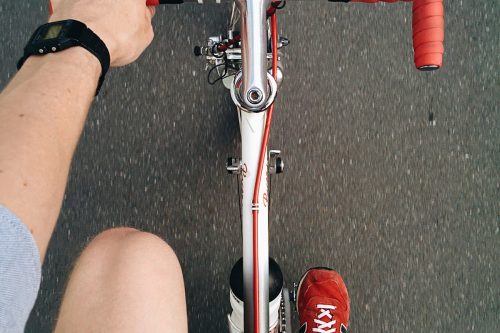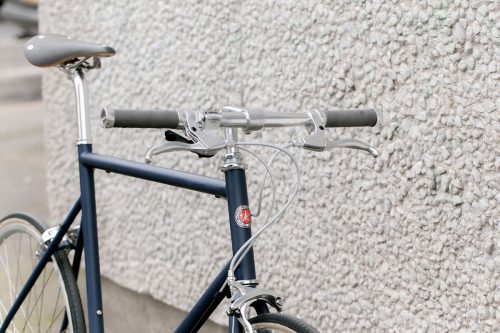A bicycle’s performance, in both biological and mechanical terms, is extraordinarily efficient. In terms of the amount of energy a person must expend to travel a given distance, investigators have calculated it to be the most efficient self-powered means of transportation. In terms of the ratio of cargo weight a bicycle can carry to total weight, it is also a most efficient means of cargo transportation.
Mechanical efficiency
From a mechanical viewpoint, up to 99% of the energy delivered by the rider into the pedals is transmitted to the wheels (clean, lubricated new chain at 400W), although the use of gearing mechanisms reduces this by 1-7% (clean, well-lubricated derailleurs), 4-12% (chain with 3-speed hubs), or 10-20% (shaft drive with 3-speed hubs). The higher efficiencies in each range are achieved at higher power levels and in direct drive (hub gears) or with large driven cogs (derailleurs).
Energy efficiency
A human being traveling on a bicycle at 16–24 km/h (10–15 mph), using only the power required to walk, is the most energy-efficient means of human transport generally available. Air drag, which increases with the square of speed, requires increasingly higher power outputs relative to speed, power increasing with the cube of speed as power equals force times velocity. A bicycle in which the rider lies in a supine position is referred to as a recumbent bicycle or, if covered in an aerodynamic fairing to achieve very low air drag, as a streamliner.
On firm, flat ground, a 70 kg (150 lb) person requires about 60 watts to walk at 5 km/h (3.1 mph). That same person on a bicycle, on the same ground, with the same power output, can travel at 15 km/h (9.3 mph) using an ordinary bicycle, so in these conditions the energy expenditure of cycling is one-third of walking.
Energy output
Active humans can produce between 1.5 W/kg (untrained women for longer periods) and 24 W/kg (top-class male athletes during 5 s). 5 W/kg is about the level reachable by ordinary male athletes for longer periods. Maximum power levels during one hour range from about 250 W (“healthy men”) to 500 W (exceptional men athletes)
Energy input
The energy input to the human body is in the form of food energy, usually quantified in kilocalories [kcal] or kiloJoules [kJ=kWs]. This can be related to a certain distance travelled and to body weight, giving units such as kJ/(km∙kg). The rate of food consumption, i.e. the amount consumed during a certain period ot time, is the input power. This can be measured in kcal/day or in J/s = W (1000 kcal/d ~ 48.5 W).
This input power can be determined by measuring oxygen uptake, or in the long term food consumption, assuming no change of weight. This includes the power needed just for living, called the basal metabolic rate BMR or roughly the resting metabolic rate.
The required food can also be calculated by dividing the output power by the muscle efficiency. This is 18-26%. From the example above, if a 70 kg person is cycling at 15 km/h by expending 60 W and a muscular efficiency of 20% is assumed, roughly 1 kJ/(km∙kg) extra food is required. For calculating the total food required during the trip, the BMR must first be added to the input power. If the 70 kg person is an old, short woman, her BMR could be 60 W, in all other cases a bit higher. Viewed this way the efficiency in this example is effectively halved and roughly 2 kJ/(km∙kg) total food is required.
Although this shows a large relative increase in food required for low power cycling, in practice it is hardly noticed, as the extra energy cost of an hour’s cycling can be covered with 50 g nuts or chocolate. With long and fast or uphill cycling, the extra food requirement however becomes evident.
To complete the efficiency calculation, the type of food consumed determines the overall efficiency. For this the energy needed to produce, distribute and cook the food must be considered.
Typical speeds
In utility cycling there is a large variation; an elderly person on an upright roadster might do less than 10 km/h (6.2 mph) while a fitter or younger person could easily do twice that on the same bicycle. For cyclists in Copenhagen, the average cycling speed is 15.5 km/h (9.6 mph).
On a racing bicycle, a reasonably fit rider can ride at 40 km/h (25 mph) on flat ground for short periods
Reduction of weight and rotating mass
There has been major corporate competition to lower the weight of racing bikes in order to be faster uphill and accelerating. The UCI sets a limit of 6.8 kg on the minimum weight of bicycles to be used in sanctioned races










Wow. There is so much I didn’t know about bikes! Thank you Megan.